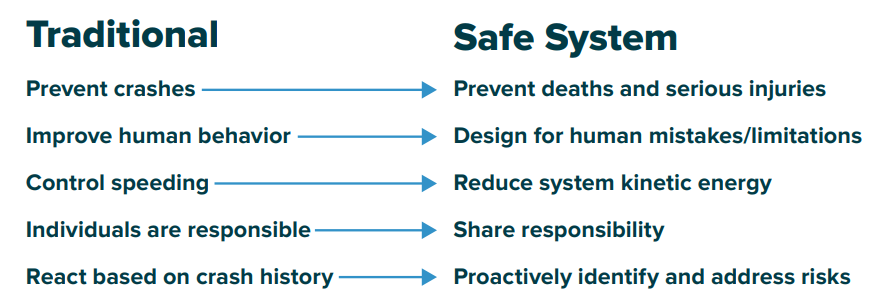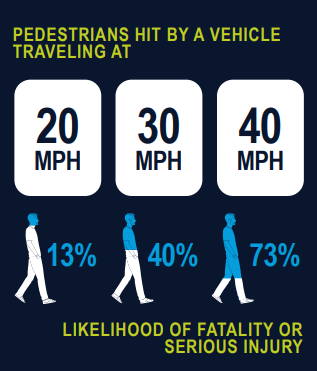Pedestrian deaths have hit another historic high in the U.S., with at least 7,508 people struck and killed while walking in 2022. Overall traffic fatalities are even worse: 12.9% Americans per 100,000 died in motor vehicle crashes in 2021–the highest in the industrialized world.
It doesn’t have to be this way. Other countries–Sweden, France, Japan–have had significant success in bending their curves, and they’ve done it by shifting how they view the issue of roadway safety, and implementing simple, often low-cost solutions that support this new approach.
The U.S. has taken notice. In January 2022, the US Department of Transportation (USDOT) released its first-ever National Roadway Safety Strategy, which identified and officially adopted the Safe System approach as “the guiding paradigm to address roadway safety.”
What is the Safe System approach?
Like Vision Zero, the Safe System approach aims to eliminate fatal and serious injuries for all road users. But unlike Vision Zero, the Safe System approach explains how to move toward that goal: first by anticipating human error, and second by minimizing the consequences of those errors.
How does it differ from traditional roadway safety approaches?
The traditional approach to roadway safety is built on the assumption that individual road users have primary responsibility over their safety, and that they can be trained to behave safely all the time. By contrast, the Safe System approach places that responsibility with roadway designers and recognizes that even with the best designs, people will make mistakes.

Source: FHWA
The task of the designer then becomes developing infrastructure and policies that keep the impacts of these mistakes at “tolerable levels.” While a Safe System can’t prevent all crashes, it can lessen their severity, by doing things like reducing speeds, adding proven countermeasures, and focusing on those more likely to be severely injured or killed in a crash (i.e. pedestrians).
What are the principles of the Safe System approach?
The Safe System approach is centered on six key principles. And they are:
-
- Death/serious injury is unacceptable. Full stop. A Safe System is one where fatalities and serious injuries are effectively eliminated.
- Humans make mistakes. We can’t expect people to behave perfectly all the time. But we can design systems that encourage safer behavior, and accommodate errors when they inevitably occur.
- Humans are vulnerable. Especially outside a vehicle, bodies can only withstand so much. Designing systems and policies that account for this is critical.
 Source: Denver Regional Council of Governments, Vision Zero plan
Source: Denver Regional Council of Governments, Vision Zero plan - Responsibility is shared. All stakeholders–designers, operators, elected officials, vehicle manufacturers, etc.–are responsible for ensuring crashes don’t lead to fatal or serious injuries.
- Safety is proactive. Rather than waiting for crashes to happen, proactive steps should be taken to prevent them through safe design and policy.
- Redundancy is crucial. Reducing risk means creating a multi-layered safety net so that if one measure fails, another is there to prevent the crash (or mitigate the severity). This idea is often conveyed as the “Swiss Cheese Model.”

Source: Washington Traffic Safety Commission
It’s time for U.S. cities to shift to the Safe System approach
As myriad cities abroad have already demonstrated, the Safe System approach works. And, as American cities have demonstrated, the status quo approach to roadway safety assuredly does not. Adopting the Safe System approach is about recognizing this simple fact and committing to do better.
Now is the time to make the shift, with unprecedented levels of funding available for safety projects via the Bipartisan Infrastructure Law. Programs like Safe Streets and Roads for All and the Highway Safety Improvement Program can be put toward infrastructure and policies that make travel safer for all road users.
We’ll give the last word to US Transportation Secretary Pete Buttigieg, who in his remarks about the launch of the National Roadway Safety Strategy said:
“We are so accustomed to hazards on our roads that we sometimes behave as if the risks of today’s roadways are inevitable. But they’re not. People should leave the house and know they’re going to get to their destination safely. Once we believe that, and believe in our ability to collectively make progress, once we demand better, we will see more positive changes cascading across governments and industry.”
